In the process of purchasing HDPE geomembrane, people are generally entangled, that is, which kind of HDPE geomembrane is better to buy. Some customers will ask our manufacturers to recommend; some customers choose expensive ones and think that expensive ones are good; and some customers buy cheap ones and think that using this material is enough, without paying attention to the details of construction and how long it can be used. Today we will introduce to you how to choose HDPE geomembrane price.
As the leading geosynthetics manufacturer and supplier, GEOSINCERE offer various types landfill liner with custom thickness and size at best factory price.
1. What Are Considerations When Selecting HDPE Geomembrane
Before purchasing HDPE geomembranes, you must determine the application area. Check if there are specific material design requirements for your project. Consider how many years you need the material to last. Decide on the desired thickness of the geomembrane. These factors help in selecting the right raw materials for production. If there are specific technical indicators, buy according to those requirements. Without specific indicators, decide on the usage duration and consult manufacturers. You can also check what materials similar construction projects use. Then purchase materials of comparable quality. The intended years of use influence the choice of HDPE geomembrane. Consult manufacturer’s personnel to match materials with your needs. Different usage durations require different raw materials in production. Longer service life means better materials to block UV rays. This results in higher costs for longer-lasting materials. Manufacturers add better materials for extended outdoor durability.


2. What Are Factors Affecting HDPE Geomembrane Price
HDPE geomembranes Price can vary widely depending on several factors, including material thickness, quality, quantity ordered, delivery location, and market conditions. Here’s a comprehensive guide to understanding HDPE geomembrane prices:
2.1 Material Thickness
HDPE geomembranes come in diverse thickness options that generally span from 0.2mm to 3.0mm or even greater for specialized applications. Thicker variants naturally require more raw materials, which directly increases their production costs. Additionally, these heavier-duty membranes offer enhanced puncture resistance and longevity that justify their higher price point. Engineers consequently select specific thicknesses based on project requirements and budget considerations. Ultimately, this range of options allows for customized solutions across different environmental and operational conditions.
2.2 Quality and Manufacturer
Reputable manufacturers with proven track records typically set higher prices for their geomembranes due to their established brand value. Additionally, these industry leaders consistently deliver superior product quality that justifies their premium pricing. Moreover, customers willingly pay more for reliable brands that offer better warranties and technical support. Consequently, lesser-known manufacturers often compete by offering lower prices to attract budget-conscious buyers. Ultimately, the market reflects this price variation based on perceived quality and manufacturer reputation.
2.3 Quantity Ordered
Customers who place bulk orders for HDPE geomembranes typically benefit from reduced unit prices due to economies of scale. Additionally, manufacturers frequently offer attractive volume discounts to encourage large purchases and maintain production efficiency. Moreover, suppliers often provide special pricing tiers that progressively decrease costs as order quantities increase. Consequently, project planners can achieve significant savings by consolidating their geomembrane requirements. Ultimately, this pricing structure makes large-scale projects more cost-effective while ensuring material consistency.
2.4 Installation Requirements
Factors such as site preparation, installation complexity, and labor costs can affect the overall project cost. Some suppliers may include installation services in their pricing, while others may charge separately.
2.5 Geographic Location
Geomembrane prices often fluctuate depending on the project’s geographical location, primarily due to varying transportation expenses. Additionally, local taxes and import duties can significantly influence the final delivered cost to the job site. Moreover, regional market conditions, including supply availability and labor rates, further contribute to price differences. Consequently, contractors must account for these location-based variables when budgeting for containment projects. Ultimately, obtaining multiple localized quotes ensures the most accurate cost estimation for specific project locations.
2.6 Market Conditions
HDPE geomembrane prices actively respond to market forces, particularly shifts in supply and demand for polyethylene resins. Additionally, fluctuating crude oil prices directly impact production costs since petroleum forms the base material. Moreover, broader economic conditions such as inflation rates and trade policies further influence pricing stability. Consequently, buyers may encounter periodic price adjustments throughout their project planning phases. Ultimately, market-sensitive pricing requires purchasers to monitor trends and time their orders strategically.
2.7 Additional Features
Certain HDPE geomembranes may come with additional features such as UV resistance, textured surfaces for improved frictional properties, or additives for enhanced chemical resistance. These features can impact the price.
2.8 Certifications and Standards
HDPE geomembranes that meet specific industry standards or certifications may be priced higher due to the additional testing and quality assurance processes involved.
2.9 Accessories and Components
The base price of geomembranes often increases when customers include essential accessories like specialized welding equipment in their orders. Additionally, supplementary materials such as high-quality seam tapes and durable fasteners further contribute to the total project cost. Moreover, manufacturers may offer package deals that bundle these components at discounted rates compared to individual purchases. Consequently, buyers should carefully evaluate whether to procure accessories separately or as part of a complete system. Ultimately, these add-ons provide necessary installation support while affecting the overall budget.
2.10 Customization
Custom sizes, colors, or specifications may incur additional costs compared to standard products.
To obtain accurate pricing information, it’s advisable to contact multiple suppliers, provide detailed project specifications, and request quotes tailored to your specific requirements. Additionally, consider factors such as product warranties, technical support, and after-sales service when evaluating different pricing options.
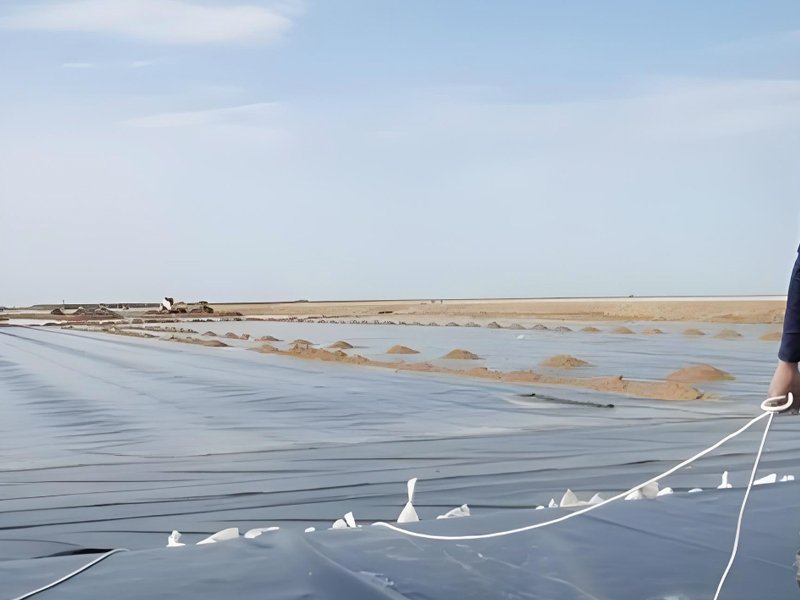

3. The Most Important Factors That Influence HDPE Geomembrane Price
The demand for HDPE geomembranes (High-Density Polyethylene Geomembranes) in construction, environmental protection, and waste management is increasing steadily. As more industries and customers explore these durable, flexible, and impermeable liners, understanding the factors that influence their price becomes essential. Buyers face a wide range of choices with varying specifications, quality standards, and manufacturers. So, what are the most critical factors that impact the price of HDPE geomembranes? Let’s take a deep dive into the key considerations when purchasing these geomembranes.
3.1 HDPE Geomembrane Price – Product Specifications: Thickness, Size, and Models
One of the most significant factors affecting the price of HDPE geomembranes is the product specification, including thickness, size, and model type. Generally, geomembranes with thicker layers cost more due to the increased material required for production. However, thickness also correlates with quality, strength, and durability.
- Thickness: The thicker the geomembrane, the more resistant it will be to punctures, tears, and environmental stress. Thicker geomembranes are typically used in more demanding applications, such as landfills, mining, and large-scale construction projects. Thus, thicker geomembranes are more expensive.
- Size and Models: Smaller sizes and specific models designed for particular uses (such as agricultural or pond liners) may have different price points. Custom sizes or non-standard models tend to incur higher production costs, impacting the final price.
- Pro Tip: Customers can optimize costs by opting for smaller specifications, provided they meet project requirements.
3.2 HDPE Geomembrane Price – Manufacturer’s Process and Quality Standards
HDPE geomembranes are manufactured using different processes, which can significantly affect both quality and price. Understanding how each manufacturer approaches production helps to evaluate the geomembrane’s overall value.
- Production Process: Some manufacturers use advanced extrusion methods that produce a more uniform, high-quality product, while others may use simpler techniques. The higher the technology involved, the higher the production costs.
- Quality Standards: Manufacturers that adhere to international quality standards and certifications (such as ISO, ASTM, or CE) may charge more for their products, as their geomembranes undergo strict testing for factors like UV resistance, tensile strength, and puncture resistance.
When comparing geomembranes, look for **technical specifications** and understand the manufacturing processes to assess whether a higher price correlates with superior raw materials and production standards.
3.3 HDPE Geomembrane Price – Raw Materials and Technology
The cost of raw materials used to produce the geomembrane can vary greatly. HDPE geomembranes are primarily made from polyethylene resin, which fluctuates in price based on market conditions.
- Raw Material Quality: Higher-grade resins often lead to a stronger, more durable geomembrane, but they also come at a higher cost. In some cases, geomembranes made from recycled HDPE may be less expensive, but they might not offer the same level of durability and resistance as virgin material geomembranes.
- Technological Advancements: Some manufacturers invest in advanced technologies such as reinforced geogrids or carbon black additives to improve the geomembrane’s resistance to UV degradation. These advanced technologies often increase the price, but they also extend the geomembrane’s lifespan and performance in harsh conditions.
3.4 HDPE Geomembrane Price – Testing and Certification
Before purchasing an HDPE geomembrane, it’s essential to understand how well it has been **tested and certified**. Comprehensive testing ensures that the geomembrane meets or exceeds specific performance standards, such as:
- Tensile Strength: Measures the material’s resistance to pulling forces.
- Puncture Resistance**: Tests how well the geomembrane can withstand sharp objects or mechanical stress.
- UV Stability**: Important for applications exposed to sunlight over time.
- Chemical Resistance**: Ensures the geomembrane is resistant to chemicals it may encounter in landfills or industrial applications.
Manufacturers that offer certified, tested products tend to charge more, but they also guarantee reliability and longevity, which can lead to long-term cost savings.
3.5 HDPE Geomembrane Price – Market Demand and Regional Pricing Variations
Regional factors can also play a role in the pricing of HDPE geomembranes. High demand in specific regions (due to construction booms, environmental regulations, or increased waste management projects) can drive up prices. Additionally, shipping costs and tariffs may impact pricing if the manufacturer is located far from the buyer’s location.
Conclusion: How to Get the Best Value for Your Budget
When purchasing HDPE geomembranes, it’s crucial to consider the balance between price and quality. Opting for a thinner geomembrane can save you money upfront, but if your project requires higher strength and durability, investing in thicker, high-quality options may save you in maintenance and replacement costs down the line.
Key takeaways for buyers:
- Compare prices and quotes from multiple manufacturers.
- Assess the material thickness and consider its relevance to your specific needs.
- Ensure the manufacturer adheres to recognized quality standards.
- Evaluate the raw material quality, production process, and technological innovations.
- Don’t overlook the importance of testing and certification in guaranteeing performance.
4. Choosing A Reliable Supplier To Quote Best HDPE Geomembrane Price
GEOSINCERE has been keeping on investing in technological innovation, manufacturing facilities improvement and turnkey engineering abilities. We have invested 10 million dollars into our manufacturing factory which is equipped with state-of-the-art automatic production lines to manufacture high quality HDPE geomembranes and other geosynthetics with optimized processes. Our extensive lines of geosynthetics products are well known for their ensured quality, high performance, excellent durability and best cost effectiveness.
GEOSINCERE brand HDPE geomembranes and other geosynthetics products and solutions can meet your requirements by our solid technologies, innovative engineering solutions and excellent customer services. GEOSINCERE always tries our best to solve the most complex civil, mining and environmental challenges with our innovative and high performance geosynthetic products. Quality assurance, factory price and fast delivery time are our competitive advantages.
Any questions, please contact us.

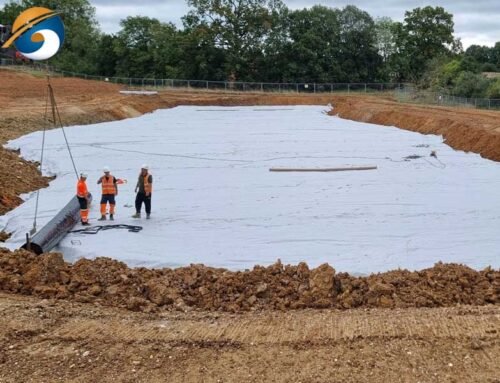
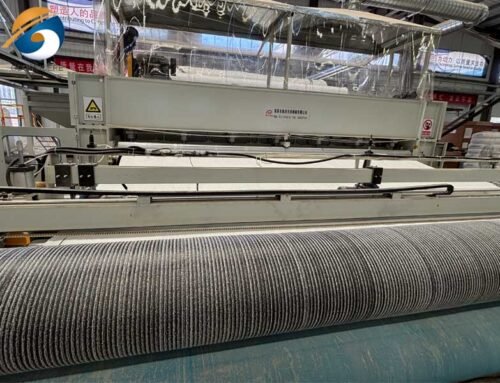
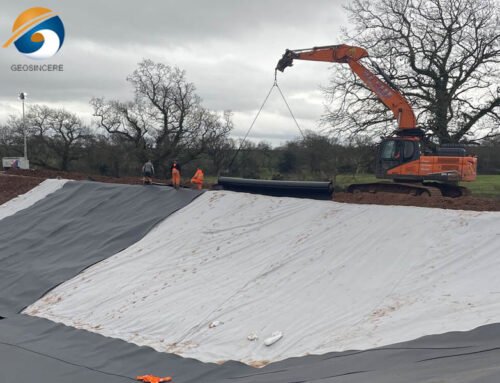
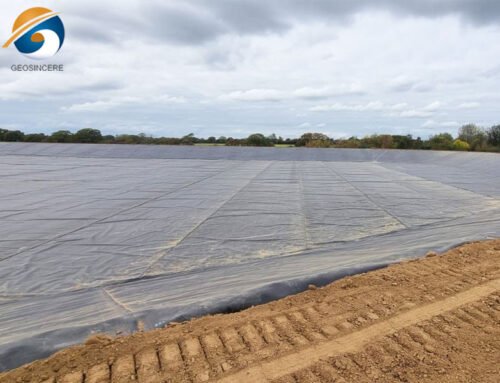
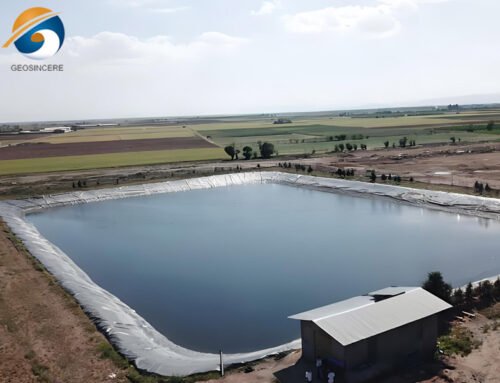
Leave A Comment
You must be logged in to post a comment.